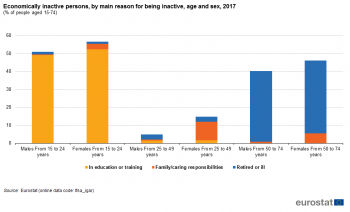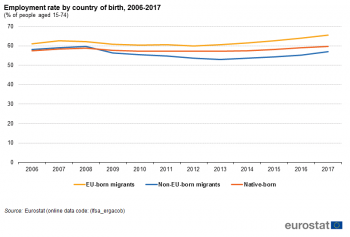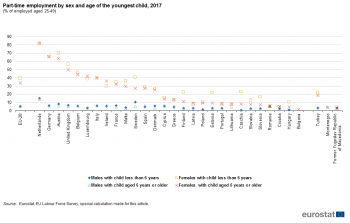Archive:Statistics on employment characteristics of households
- Data extracted in January 2019. Most recent data: Further Eurostat information, Main tables and Database. Planned article update: January 2020.
European Union Labour force survey - Annual results 2017
This article presents some of the main results for 2017 of the EU Labour force survey (LFS) for the European Union (EU) as a whole, for all Member States individually, as well as for two candidate countries and three EFTA countries.
This article complements the articles Employment Statistics , Employment rates and Europe 2020 national targets, Underemployment and potential additional labour force statistics, and Unemployment statistics and beyond.
This article is divided into two parts: the first part analyses the labour market using household information. The second part of this article is dedicated to the labour market at individual level,


<thumb src="Infographic Labour Force Survey.jpg">
Infographic 1: Labour market in the EU, 2016
Click on the image for an interactive view of the data. Click on the arrow icons to expand the bars.






Labour market analysis using household information
Main household types
The most common household type in the EU-28 in 2017, seen from a labour market perspective, was households where all adults were working (44 % of all private households) (Figure 1). This was followed by households where none of the adults were working (35 %). In the remaining 20 % of the households, at least one adult was working and at least one adult was not working. Among the EU Member States, Sweden had the highest percentage of households where all adults were working (65 %), Greece the highest percentage of households where no adults were working (45 %) and Malta the highest percentage of households where at least one adult was working and at least one adult was not working (35 %). For further information about household composition, please look at the statistics explained article Household composition statistics .
Effect of having children
Another approach to household-based labour market analysis is to compare the situation of persons with and without children. The figures 2 and 3 are limited to persons aged 25-49 years, so that different national situations for pupils, students and retired do not influence the results and do not compromise the comparability between countries. In 2017 in the EU, more than 1 women with children in 3 worked on a part-time basis (36.1%). Figure 2 shows that part-time work differs significantly between men and women. This difference by sex is even bigger for persons having children. In all countries, the proportion of women aged 25-49 having children who were employed on a part-time basis is higher than the same indicator for men. The gap between males with children and women with children for the part-time work rate was 30.8 p.p. in EU-28 in 2017. Concerning males and women without children this gap is lower (10.6 p.p.). It is in Romania, Bulgaria, Montenegro and the Former Yugoslav Republic of Macedonia than the difference between Males/Females, Presence/Absence of children are the less visible. In these countries part-time employment rates are low. Presence of children influences a lot women part-time work rate in Germany (24.5% females without children worked on part-time vs. 65.6% females with children worked on part time), Austria (29.3% vs. 66.0%) and United-Kingdom (16.2% vs. 52.7%). This means that women in these countries rather shift to part-time work than leave the labour market when they have children.
Figure 3 shows that the part-time rate of women and men increase when they have young children (less than 6 years). For the EU-28, 39.3 % of women who worked and who have young children, worked part-time in 2017. The corresponding figure for women who have children aged 6 years or more is 34.0 %. On the opposite, the part-time work rate of men is not affected by the age of the children: it nearly always stays below 10 %. In 26 of the 28 EU member states the part-time work rate of men with young children is less than 10%. The only exception were in Netherlands where 15.2% of men with young child worked on a part-time basis and in Sweden (10.3%).
Labour market analysis at individual level
Population by labour status
INFOGRAPHIC TO UPDATE
Infographic 1 shows the main sub-populations and their relative and absolute size, as they are defined in the Labour Force Survey (LFS). Among the total EU population in 2017, 380.2 million were aged 15-74 (which is the focus population for employment and unemployment). Of these, 245.8 million were economically active ; 134.4 million were consequently economically inactive. Furthermore, 227.0 million persons were in employment , while 18.8 million were unemployed . Employees (192.0 million) far outnumbered self-employed (32.7 million), and full-time work (181.3 million) was much more common than part-time work (45.7 million).
Employees versus self-employed
The vast majority of persons who work are employees. For the EU-28 population aged 15-74, this number stood at 85.0 % in 2017 (Figure 4). Some differences exist across countries but the general pattern holds for all of them: employees outnumber self-employed by a wide margin everywhere. In only four countries is the proportion of employees below 75 % (Romania, Greece as well as the Candidate country Serbia and Turkey). Seven countries have more than nine out of ten working persons as employees (Denmark, Luxembourg, Sweden, Germany, Estonia, Hungary as well as the EFTA country Norway).
One in ten persons who work was self-employed without employees (own-account workers) (10.3 %) and 4.1% was an employer (self-employed with employees) in the EU-28 in 2017. The levels nevertheless differ substantially between countries, as own-account workers make up close to a quarter of persons in employment in Greece (22.8 %) and only 4.7 % in Denmark. Self-employed with employees are less common, ranging from 1.1% in Romania to 7.3 % in Greece.
Figure 5 shows that 46.0 % of the employees were women in the EU-28 in 2017. On the opposite, 54.0% of the employees were men. In other words, we are close to the gender balance for the number of employees. Among Member States this situation ranges from 51.3 % of women employees (Lithuania ) to 40.0% in Malta. When it comes to self-employed, the picture changes markedly. At EU level there were two self-employed men for each self-employed woman in 2017 (32.3 % of self-employed are women). In Malta, only a self-employed persons in five is a women (22.5%). In Turkey, only 15.4% of the self-employed are women in 2017.
For further information about Self-employment, please look at the statistics explained article Self-employment statistics .
Working hours in the main job
The usual working week (main job only) in the EU in 2017 was 37.1 hours. Among Member States, the longest working weeks can be found in Greece (42.0 hours per week) and the shortest in the Netherlands (30.3 hours per week). If all countries are taken into account, the longest working weeks were recorded in Turkey (46.4 hours per week) (Map 1).
It is important to note that these numbers are influenced by the proportion of the work force which works part-time (more part-time means lower average hours), the composition of the economic activities (working weeks are longer for farmers, construction workers, manufacturing workers), the proportion of self-employed (self-employed work longer hours), and the activity rate of women (women work shorter weeks than men).
When only full-time employees are considered, the EU average working week in the main job in 2017 corresponds to 40.2 hours. Men had a longer working week than women, working on average 40.9 hours compared with 39.3 hours for women. Those in the mining and quarrying industry worked the longest hours (42.0 hours), while the shortest working week is to be found in the education sector (38.0 hours). Looking at countries' situation (Map 2) only one Member State (United-Kingdom, 42.1 hours) had an average working week (full-time employees) superior to 42 hours. Apart from EU, in five countries full-time employees had an average working week larger than 42 hours: the Former Yugoslav Republic of Macedonia (42.3 hours), Serbia (42.9 hours), Montenegro (43.6 hours), Iceland (44.0 hours) and the maximum in Turkey with 49.1 hours. Most of the countries (18 countries) had full-time employees working between 40 and less than 42 hours per week. This group contains mainly Eastern countries.
Economically inactive persons
In order to complement the articles which analyse the labour market through the employment and unemployment rates (see links at the top of this article), we will look here at the inactivity rate. This rate tells us how many persons are economically inactive out of the total adult population in the country. Those who stay outside the labour market do so for many different reasons: they can be for instance in education, retired, staying at home to look after children, ill or incapacitated dependants.
Figure 6 shows that the situations of men and women in 2017 in the EU-28 were very similar to each other for inactivity due to education and inactivity due to retirement. In the age group 15-24, 49.1 % of the men were economically inactive due to education, resp. 52.3 % of the women. If we look at the older age group (50-74 years) and the inactivity because of retirement or illness, the shares were 39.4 % for men and 40.4 % for women.
However, when it comes to staying outside the labour market because of family obligations, the shares for men and women differ widely. For persons aged 25-49, only 0.6 % of the men were economically inactive for this reason in 2017 whereas the corresponding percentage for women was more than 17 times higher, i.e. 10.3 %.
Discouraged job seekers can also be found among economically inactive people (Figure 7). They are those who would have liked to work, but have given up looking for a job because they believe that it is not possible to find one. It is a key point to understand that a high inactivity rate will push the unemployment rate down, as it takes these persons out of the equation for the unemployment rate. At the EU level the discouraged job seekers made up 0.9 % of men and 1.3 % of women aged 15-74 in 2017.
There are notable differences between countries: Portugal, Italy and Croatia as well as the candidate country Serbia and Montenegro have relatively many discouraged job seekers, whereas this group of persons is quasi non-existent in Austria and the United Kingdom. In 20 Member States Women are more numerous to be discouraged than Men. This gap is largest in Portugal (2.1 p.p.) followed by Italy (1.6 p.p.) and Croatia (1.4 p.p.). However in seven Member States (Bulgaria, Latvia, Finland, Estonia, Ireland Lithuania and United Kingdom) Men tend to be more discouraged than Women.
A more comprehensive analysis of all the aspects of underemployment is published at Underemployment and potential additional labour force statistics.
Foreign workers in the EU
EU-immigrants, that is, persons who live and work inside the EU but who were born in another EU Member State, have a very similar employment rate to that of natives with the same time evolution (Figure 8). Since 2002, the employment rate of EU-immigrant and native has increased overall, with an increase of 4.3 p.p. at EU level for EU-immigrant and 2.2 p.p. for native. The employment rate of Non-EU immigrant (born outside the EU) has decreased from 58.2% in 2006 to 56.9% in 2017.
Moreover immigrants have a higher employment rate than the natives for all years from 2006. The situation is different for non-EU immigrants. Since 2009, the employment rate of non-EU immigrant has been markedly lower than the natives employment rate. People born in another EU countries tend more to being in employment than people born outside the EU.
Figures 9 shows the employment rate of persons born in another EU country by sex. In EU, in 2017, the employment rate of Men immigrants born elsewhere in the EU was 72.1% whereas it was 59.3% for women (gap 12.8 p.p.). In all countries the employment rate of Males immigrants are superior to the employment rate of Females immigrants. This gap is largest in Greece (20.9 p.p.) followed by Latvia (19.4 p.p.) and smallest in Slovenia (2.5 p.p.). Portugal and Iceland are the only countries where both Males and Females rates are bigger than 75%.
Figure 10 illustrates also a gender gap for the non-EU born employment rate. The employment rate of women immigrants is lower than the employment rate of men immigrants in all countries except in Cyprus. In 7 of the 27 Member States for which data are available in 2017, the employment gap are larger than 20 p.p. The situation in Turkey was noticeable as the gap reached 45.3 p.p. in 2017, only 18.0% of females immigrants born outside the EU were in employment. In three Member States, the employment rate for migrant women born outside the EU was less than 40%: Greece (39.3%), France (39.1%) and Belgium (36.8%).
A more in-depth analysis of migrant statistics is published at Migrant integration statistics.
Data sources and availability
Source: the European Union Labour Force Survey (EU-LFS) is a large sample, quarterly survey providing results for the population in private households in the EU, EFTA and the candidate countries. Conscripts in military or community service are not included in the results.
Reference period: Yearly results are obtained as averages of the four quarters in the year.
Coverage: The data for France cover the metropolitan territory (excluding overseas regions) Country codes: Belgium (BE), Bulgaria (BG), the Czech Republic (CZ), Denmark (DK), Germany (DE), Estonia (EE), Ireland (IE), Greece (EL), Spain (ES), France (FR), Croatia (HR), Italy (IT), Cyprus (CY), Latvia (LV), Lithuania (LT), Luxembourg (LU), Hungary (HU), Malta (MT), the Netherlands (NL), Austria (AT), Poland (PL), Portugal (PT), Romania (RO), Slovenia (SI), Slovakia (SK), Finland (FI), Sweden (SE), the United Kingdom (UK), Iceland (IS), Norway (NO), Switzerland (CH), the former Yugoslav Republic of Macedonia (MK), Turkey (TR). The abbreviation MK used for the former Yugoslav Republic of Macedonia is a provisional code which does not prejudice in any way the definitive nomenclature for this country, which will be agreed following the conclusion of negotiations currently taking place on this subject at the United Nations.
European aggregates: EU refers to the sum of EU-28 Member States and EA to the sum of the 19 euro area Member States. If data are unavailable for a country, the calculation of the corresponding aggregates takes into account the data for the same country for the most recent period available. Such cases are indicated.
Definitions: The concepts and definitions used in the survey follow the guidelines of the International Labour Organisation.
•Employment covers persons aged 15 years and over (16 and over in Spain, Italy and the United Kingdom, 15-74 years in Estonia, Latvia, Hungary, Finland, Sweden, Norway and Denmark, and 16-74 years in Iceland), living in private households, who during the reference week performed work, even for just one hour, for pay, profit or family gain, or were not at work but had a job or business from which they were temporarily absent, for example because of illness, holidays, industrial dispute or education and training. The LFS employment concept differs from national accounts domestic employment, as the latter sets no limit on age or type of household, and also includes the non-resident population contributing to GDP and conscripts in military or community service.
•Employees are defined as persons who work for a public or private employer and who receive compensation in the form of wages, salaries, fees, gratuities, payment by results or payment in kind; non-conscripted members of the armed forces are also included.
•The distinction between full-time and part-time work is generally based on a spontaneous response by the respondent. The main exceptions are the Netherlands and Iceland where a 35 hours threshold is applied, Sweden where a threshold is applied to the self-employed, and Norway where persons working between 32 and 36 hours are asked whether this is a full- or part-time position;
•Unemployment covers persons aged 15-74 (16-74 in Italy, Spain, the United Kingdom and Iceland) who were not employed during the reference week, were currently available for work and had either been actively seeking work in the past four weeks or had already found a job starting within the next three months.
Definitions of indicators reported in this publication are available on the EU-LFS Statistics Explained website: EU Labour Force Survey (Statistics Explained)
Context
The EU-LFS is the largest European household sample survey providing quarterly and annual results on labour participation of people aged 15 and over as well as on persons outside the labour force. It covers residents in private households. The EU-LFS is an important source of information about the situation and trends in the EU labour market.
Each quarter around 1.8 million interviews are conducted throughout the participating countries to obtain statistical information for some 100 variables. Due to the diversity of information and the large sample size the EU-LFS is also an important source for other European statistics like Education statistics or Regional statistics.
See also
Further Eurostat information
Publications
Main tables
Database
Dedicated section
Methodology / Metadata
Notes
- ↑ Missing lines denotes that the results are below the publication threshold
